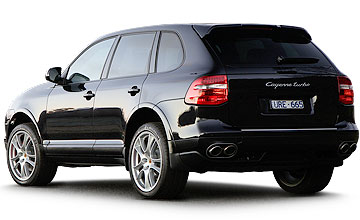BY JAMES STANFORD | 30th Mar 2007

Is the six-cylinder that is also used in the Volkswagen Touareg and Audi Q7 – with minor revisions – good enough for a Porsche?
Will the V6 cope with its 2160kg bulk in a country where traffic-light acceleration is a core part of a car’s performance?
We simply cannot answer these questions because Porsche Cars Australia did not want us – or any Australian journalists, for that matter – to drive the SUV and compare it with the more powerful V8 models at its Australian launch.
What we can tell you is that the V6 Cayenne is slower than a standard Ford Falcon in 0-100km/h acceleration using Porsche’s claimed figures and enthusiast magazine performance testing of the Ford.
The base Falcon takes less than 8.0 seconds to reach 100km/h from standstill, while the V6 Cayenne takes 8.5 seconds – which is about the same time as Ford’s Territory SUV.
The V6 Cayenne is also 0.4 seconds slower to from 0-100km/h than the BMW X5 3.0 Si, which would no doubt delight BMW customers who paid $12,400 less for the privilege.
We will have to wait until Porsche releases V6 Cayennes for testing to find out how this translates in real-world driving.
We were able to test both the V8 S and V8 Turbo versions of the revised Cayenne at launch – but, again, in tightly controlled circumstances … only on tarmac.
Porsche Cars Australia claims that only about five per cent of customers drive their Cayennes off-road, despite the fact that the SUV is fitted standard with low-range gearing and adjustable ride height to enable bush work.
All of the vehicles on the launch were also fitted with the optional ($7390) Porsche Dynamic Chassis Control system – which is engaged at all times – so we can’t predict how the regular models will handle.
What we can say is that the vehicles fitted with Dynamic Chassis Control handle particularly well when you consider their considerable weight and large dimensions.
A Cayenne Turbo, also fitted with optional 21-inch rims, provided a good example of how smart engineering can almost tame a big and bulky SUV.
The Cayenne rides more like a sportscar than a 4WD wagon on the tight and twisty road section that runs up to Mount Hotham. It is a surreal experience to be punting along at such pace when you are looking down at the road from a towering height.
The best technology can’t change the rules of physics – you still notice its weight and size – but the new Cayenne certainly bends them.
The 21-inch rims and the low-profile rubber wrapped around them are great for this type of driving, but lead to an uncomfortable ride when the road surface deteriorates.
Our choice would be the standard 18-inch rims with higher-profile rubber.
The standard Cayennes lean and squirm a bit more through the corners, even when fitted with Dynamic Chassis Control, but help provide a much more comfortable ride on sometimes rough country tarmac.
The twin-turbocharged Cayenne Turbo makes the most impact with its ferocious double-boosted engine doing its best to overcome the vehicle’s weight penalty.
Its sounds great with a lovely V8 bellow, but the induction roar above 5000rpm is also worth waiting for.
As strange as it sounds, there is still a bit of a pause as the turbos spool up.
This engine is not fitted with the variable geometry turbos of the 911 Turbo that could possibly reduce this type of lag.
The standard V8 engine is not as potent, but it is the more enjoyable of the two powerplants.
Its linear power delivery means it is easier to drive smoothly and has enough torque to keep the Cayenne hustling along.
The Cayenne interior doesn’t appear all that much different to that of the existing model and is exactly what you expect. There is enough space for a big family, which can’t be said for any other models in its range.
The only quality issue on the launch was a piece of loose plastic trim in one car, which is surprising given that Porsche insists on running-in each media test car in Germany and thoroughly checks any car before it is sent out.
Porsche designers have done a great job to sharpen up the exterior styling of the Cayenne after the first-generation model was mocked for its bulbous shape.
Its chiselled front-end makes the Cayenne look more aggressive, while the Turbo’s huge airdam makes it clear there is something special under its bonnet.
The V8 Cayennes are quite expensive, especially when you consider much of the basic vehicle was jointly developed with the Volkswagen Touareg, but do perform well considering the related restraints of a large 4WD.
We will have to wait and see if the V6 version will do the same or simply represent a backward step for the brand.